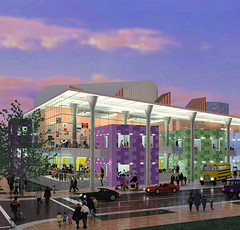Growth can be an opportunity to create livable neighborhoods
The Friends of Seattle blog points us to this op-ed that appeared in the Seattle Times earlier in the week.
I happen to agree that growth is an opportunity to make neighborhoods more livable, because you need a basic threshold of people (critical mass/agglomeration) in order to support the kinds of things that comprise livability such as:
- neighborhood schools;
- parks and green spaces;
- viable local commercial districts including full-service grocery stores (which don't have to be gargantuan but should have fresh produce), pharmacies (CVS acts as a convenience store too), a hardware store and a post office;
- people out and about to provide activity, be customers, eyes on the street, and involved citizens;
- frequent transit services (I am not sure what is the least amount of service that is tolerable, I'd say every 12 to 15 minutes, if the service is reliable).
From the Seattle Times article:
Focusing growth in urban villages encourages compact and walkable neighborhoods that allow people to walk, bike or take transit to reach their homes, jobs and community services. The June 30 passage of the revised Multi-Family Tax Exemption program will encourage more housing options for a wider range of incomes in those neighborhoods. With today's challenges of global warming, there is simply no other conscionable way that we can grow.
The proposal before the City Council to update station-area plans before light-rail service begins is another step in the right direction. More people should have the opportunity to live and work close to light-rail stations, where they will have real transportation choices. Better station-area planning will let us leverage that multibillion-dollar regional transit investment to create vibrant, transit-oriented neighborhoods where people can live and businesses can thrive.
The greatest challenge is providing amenities and infrastructure to support the growing population. Again, Seattle has made a lot of progress on this front. The city has tripled bike and pedestrian funding in the past few years. Capped reservoirs will add about 76 acres of open space. The city's libraries have been renovated or replaced.
But as gas prices approach $5 per gallon, better transit is the critical amenity that Seattleites need. There is understandable frustration at overcrowded buses. The city will spend $12 million from 2008 to 2015 for 45,000 new hours of bus service from Metro — but that still won't meet the need. ...
While growth can be a burden to neighborhoods where plans are outdated or inadequate, it is also a chance to create a vibrant, livable urban environment. Throughout the city, buildings are being upgraded and reused, improving neighborhood quality.
In Phinney Ridge, for example, a small, family-owned grocery is expanding due to increased foot traffic from recent condo development. It's a happy moment for neighborhood-scale retail and the citizens of Phinney.
To make this work you have to have design guidelines and urban design requirements in place, or you get, for the most part, dreck, because value engineering reigns. And by not focusing growth on extant areas, you have to extend infrastructure--spending more money--and you create what I call intra-city sprawl deconcentrating economic activity and the value of transit, increasing trips and the time required to accomplish basic tasks.
I don't think we really do neighborhood planning though. And at the same time, we don't adequately balance city-wide provision of services vs. neighborhood-based services. For example, given that DC is pretty small, it isn't necessary to have recreation centers or libraries in every neighborhood, sub-regional services can be adequate within wards or areas (see the area elements of the comprehensive plan).
At the same time, some of the "regional" services such as recreation centers or libraries can have enhanced offerings that in turn serve the rest of the city. For example, we could have a stupendous children's library with a theater etc., like the Imaginon in Charlotte, NC, a library specializing in health and wellness (in Baltimore County, one library has a senior center attached)or a couple recreation centers in the city could also have indoor tracks and facilities capable of serving multiple uses from exhibitions to the roller derby.

Imaginon -- Children's Library/Theater, Charlotte, NC (rendering).
But without adequate master planning, no capital improvements plan, and lack of adequately linked planning between silos--I mean government agencies--we don't get it and we waste money.
For example, Marc Fisher wrote a column yesterday, "D.C. Libraries Mired in Political Dithering,"about the debacle with the DC Libraries and constructing new libraries in places where extant libraries have been demolished
Fisher doesn't get into the fact that the "blue ribbon" library master plan has never been adequately vetted and that it was about 65% "not good." He does make the point that in the meantime while DC has fiddled and demolished libraries, neighborhood jurisdictions have gone ahead and built superlative facilities in the same time.
The quotes are weird. The head librarian says she is working to get the agency to consider multi-use facilities but that they aren't ready and therefore they should bull ahead and rebuild now as single use facilities for the most part.
That is an amazingly short-sighted viewpoint. In theory these are "final" decisions. Libraries built in Tenley, Shaw, Ward 7 and elsewhere will not be rebuilt in our lifetimes--at least they shouldn't be. Not to mention that DC can't afford to waste any of its dollars, it needs to maximize the return on value to the citizens.
Given that John Hill has been removed from the Children and Youth Investment Trust (see "Appointments Spark Hearings: Some Charge Mayoral Meddling in Personnel Changes," from the Post), I wonder if his days are numbered as Board chair of the DC Library System. I doubt it, given his role with the Federal City Council. But it is odd that he got bounced from a city commission.
Labels: sustainable land use and resource planning, urban design/placemaking



0 Comments:
Post a Comment
<< Home